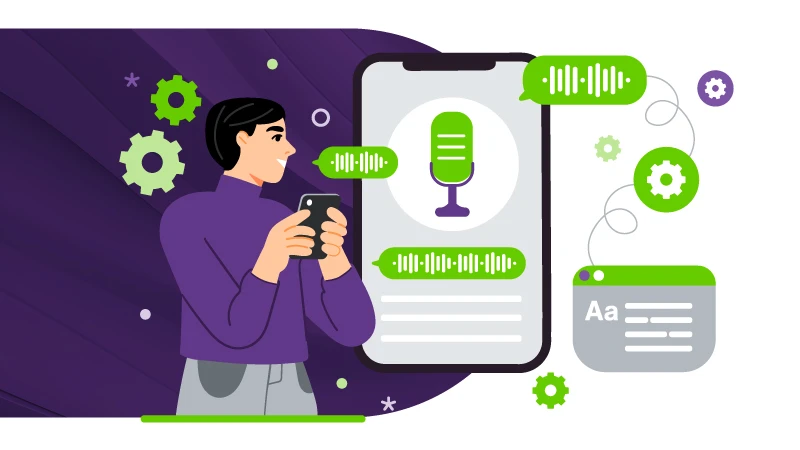
Can you hear that?
That's the sound of a paradigm shift. The reverberations are being caused by advances in voice technology and generative AI (GenAI). On a recent episode of our podcast, Questions for now, Tobias Dengel, president of TELUS Digital Solutions & WillowTree, a TELUS Digital Company, asserted that this represents "the next big wave [in technology] — as big as the internet or as big as mobile."
That may seem like a bold claim, but it is backed by real authority. Dengel literally wrote the book on voice technology, a national bestseller titled The Sound of the Future: The Coming Age of Voice Technology. In a Forbes interview, Dengel noted that in the next five years, there will be "more innovation than there's been in the last five or maybe the last 20 years, as conversational AI and generative AI come together."
There are several relevant technologies that are facilitating this potential for innovation. There's voice recognition, which occurs when a machine is able to receive verbal commands and queries. There's natural language processing (NLP), which takes the unstructured verbal inputs and standardizes them so that a machine can take further action. There's natural language understanding (NLU), which helps machines recognize the intended meaning of language, for example, via named entity recognition. And, of course, there is generative AI, which is capable of creating novel, context-aware responses to natural language prompts. With the combination of these technologies, there is every reason to believe voice interaction with conversational AI will be increasingly prominent within the wider customer experience context.
Read on for a look at how voice technology and GenAI are changing our relationship with technology.

Everest Group survey results: Enterprise readiness for generative AI adoption in customer experience management
Everest Group, supported by TELUS Digital, surveyed 200 customer experience leaders from around the world to determine their enterprise readiness for the adoption of generative AI (GenAI). Discover the results.
Generative AI is ushering in a new era of voice assistants
Until now, people have generally used voice assistants on their devices to make simple commands or ask simple questions. Think "Turn on the kitchen lights" or "What is the capital of South Africa?" These are called single-turn conversations. They require no further context and they are used to prompt one specific result without additional back and forth.
With generative AI, conversational bots are equipped to hold their own in multi-turn conversations. You can tell a GenAI-powered chatbot to assume a particular role, refer back to earlier parts in your dialogue and ultimately build context over the course of the conversation. Imagine you're trying to fix a leaky faucet. While you're under the sink, you might converse with a voice assistant, asking for assistance, trying different recommended solutions, relaying the results and asking for clarification or rephrasing of instructions that you don't understand. All of this without having to come out from under the sink.
"Fundamentally, this is the first time we're able to speak to computers in our language," argued Bret Kinsella, founder, CEO and research director of Voicebot.AI, on the aforementioned Questions for now episode. He continued by explaining that "all of the interaction with technology, whether it be the printing press, the car, the computer, we were always using some tool that the machine could understand in order to make the machine do something for us. With natural language processing, voice, voice-first, these capabilities mean we can communicate with them like we would another person," before concluding that this is particularly useful when we don't know exactly how to word what we're looking for.
Kinsella shared that he believes this will lead to a massive proliferation of voice assistants, with brands creating countless voice-enabled bots to support customers and employees alike. "I'll say there's going to be a billion assistants," Kinsella claimed.
Dengel is similarly optimistic about voice technology and explained that voice will become the "primary way" we tell machines what to do. Even when it might seem like we're making a simple request, advances in voice technology are going to result in better customer outcomes. "It might connect us to customer service [...] and customer service knows what we were trying to do in the app and that we're pre-authenticated, et cetera. So it takes so much friction out of the customer service experience," said Dengel.
The applications for voice technology are innumerable. For example, voice-enabled banking apps will be capable not just of surfacing a knowledge base article when you need assistance, but of understanding what you're looking for, explaining it and rephrasing it if necessary, walking you through the steps and even actioning your requests like transfers and account updates. In an internal context, employees will increasingly rely on voice technology to summarize meetings, seamlessly acting on takeaways like documenting notes, drafting emails and assigning action items.
Voice tech promises improved speed and accessibility in CX
There are two key benefits that stand out when it comes to voice technology and the delivery of voice-first experiences. First, voice tech is bringing new levels of efficiency to customer interactions and getting customers what they're looking for, faster. Second, voice tech is broadening accessibility, ensuring more customers can get the support they need.
Voice-first experiences can be quick and painless
Inherent to the idea that voice is the next big wave in technology is the concept of multimodal voice. If you're able to dictate to a voice assistant that you'd like to book a specific type of hotel room on certain dates and with several add-ons, and then have your smartphone process that information and show your confirmation on your screen, that's a low-effort experience. With multimodal capabilities, you don't have to search for all the right options on your phone and you don't have to take the time to listen to a voice reciting all of your choices back to you. That can reduce friction and speed up the process.
In the aforementioned podcast interview, Dengel explained, "The reason we want to use voice at the end of the day is because it's so fast versus typing, three times as fast as on a keyboard, five times as fast as on a mobile device. So we always are wanting to speak into our devices, but it's also super slow to listen to transmissions and hard to remember what's going on versus a screen. The early applications have completely missed that. And it goes all the way to the nomenclature we use. We call them smart speakers, which is entirely backwards. They should be smart mics. We want to be talking to them, not listening to them."
Rather than relying on the hypothetical, innovative brands are working with WillowTree, a TELUS Digital Company, to seize the opportunity to use voice as a way to reduce customer effort and create better customer experiences. As an example, Dengel cited a partnership with a large beverage manufacturer with vending machines and fountain systems in restaurants that need periodic maintenance. "And that's just a perfect voice application, right? Because we know using location data, what machine you're standing in front of. So we know the model, we know what the parts are, we know what the most likely parts are to break," explained Dengel. This location data, in combination with a voice technology implementation, has enabled maintenance technicians to submit requests for parts with voice and save considerable time that they would have spent with the location arduously searching catalogs.
Tobias Dengel, president of WillowTree, a TELUS Digital Company, speaking about multimodal voice interfaces on the Questions for now episode: "Has the time come to prioritize voice-first experiences?"Voice technology broadens accessibility in CX
There's no shortage of reasons why customers might not feel that they have equal access to customer service. Maybe they struggle with reading comprehension and they can't make sense of the self-serve options you're directing them to. Or maybe they're not comfortable with technology and navigating your menus and interfaces. Or they are a person with vision impairment or low vision and need other ways to get support.
For the queries that would typically be solved by your self-service channels, including FAQ pages and chatbots, voice assistants represent a significant customer experience opportunity for brands. Much like the hypothetical voice assistant in banking mentioned earlier, this would enable customers to explain themselves in natural language, hear nuanced responses to their questions, and action requests without the use of a keyboard or screen. So long as human support is available to those who need it, thinking about the ways voice can be integrated into your CX strategy is an important step forward.
Another significant boost to accessibility comes in the form of real-time language translation made possible by generative AI. If you don't have agents who speak the language of members of your customer base, GenAI is making it possible for customers to speak in their preferred language and for agents to reply in theirs via simultaneous translation. "There are many, many languages spoken in India and Africa that have very small bases of users that have been excluded largely from the digital world that are going to be starting to participate through these technologies. It's going to allow things like customer service to happen in real time between people that don't speak the same language," explained Dengel.
It should also be noted that voice technology increases accessibility in terms of innovation. With GenAI-fueling voice assistants, keyboards don't have to be the only way to convey instructions to our machines. You can imagine a mobile app being developed by voice prompts dictated to a generative AI assistant capable of coding, for example. This and a host of other possibilities will be unlocked, offering alternatives to traditional input methods.
Adapt to the next big wave in technology
These are exciting times for brands looking to deliver genuinely simple, accessible experiences to their customers, and that's the result of the combined power of voice technology and generative AI. It's time to adapt to the next big wave in technology. Contact us today to see how voice tech and GenAI can drive better outcomes for your customers and your business.



